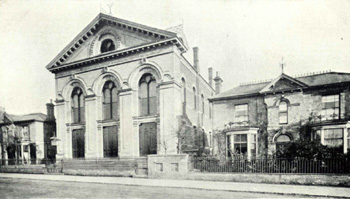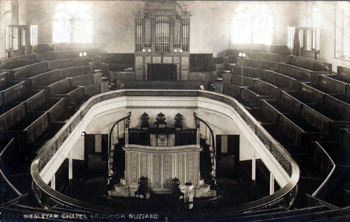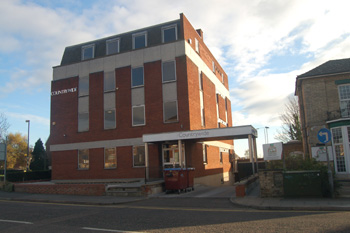Hockliffe Street Wesleyan Methodist Church

Remains of the chapel behind 14 to 16 Hockliffe Street November 2008
The Wesleyan Methodist chapel in Leighton Buzzard was in Hockliffe Street, also known as Jeffs Lane and was stated, in the Ecclesiastical Census of 1851, to have opened in 1803. The earliest record held by Bedfordshire & Luton Archives & Records Service is the Circuit Class Book, which begins in 1812. The Wesleyan chapel "in Jeff's Lane" was registered on 10th January 1838. Registration bought the benefit of exemption from parish poor rates, exemption from control by the Charity Commission and the right to be licensed to carry out marriages.
On Sunday 30th March 1851 a census of all churches, chapels and preaching-houses of every denomination was undertaken in England and Wales. The local results were published by Bedfordshire Historical Records Society in 1975 as Volume 54, edited by D.W.Bushby. The return for the Jeffs Lane Wesleyans was made by John Nevill, the Superintendent Minister who stated that the meeting had seating for 700. Attendance had been 260, with an additional 244 Sunday Scholars, in the morning, 270, with an additional 261 Sunday Scholars, in the afternoon and 500 in the evening – impressive grand totals of 504, 531 and 500.
The Wesleyan chapel was registered on 19th April 1861 by Joshua Mottram of Leighton Buzzard, minister, this was cancelled on 31st December 1866 after registration of the new chapel further east in Hockliffe Street on 17th March 1865 by James Sutch of Leighton Buzzard, minister (this was cancelled on 1st September 1960). The chapel was registered for marriages three days later.

Wesleyan chapel about 1910 [Z1306/72]
The old chapel was sold to the Grove Walk Baptists in 1865. An anonymous account of the move to a new chapel is included loose in the General Chapel Committee minute book for 1862 to 1868 [MB258]. It begins: "In the year of 1857, during the ministry of Revd.W.Piggot and Revd.John Walters, the old chapel now used by the Baptists was one of the coldest, most uncomfortable meeting houses, situated as our forefathers seemed to prefer. The walls were a dirty light drab not painted. The pews were straight and high. The gallery front and the pews were all of the same sombre drab. The pulpit was a heavy looking round affair standing on a pedestal painted a heavy, miserable imitation of mahogany. The free seats at that time were forms with backs immediately in front of the pulpit. Many of the congregation looked as sombre as the chapel itself".
The writer went on to state that both the chapel and the Circuit were heavily in debt. Some who attended "were constantly sewing not deeds of kindness so altogether the prospect was not encouraging". However, new blood came into the church who were "dissatisfied with the state of the Chapel and began to make a move to improve the appearance". Over £100 was raised and the chapel was cleaned and renovated.
A general revival of fortunes then took place so that the chapel became too small for the congregation and a new chapel became necessary. "Much difference of opinion as to site existed. Some contended that a New Chapel at Linslade and an extra minister would be best, others that a good chapel nearer Linslade would be best. Others thought towards North Street would be best. After much talking and many suggestions the site on which the 3 houses and Chapel now stand was approved". The site was on the south side of Hockliffe Street and was owned by George Franklin. It was copyhold land of the Manor of Leighton alias Grovebury and Franklin had inherited from his father, Henry Hawkins Franklin in 1852. The deeds [CCE2745] begin with an abstract of title going back to 1798. In that year William Sanders, innkeeper, was admitted to the George Inn in Leck End [Lake Street] and a close of pasture of two acres adjoining.
Sanders died and in his will, of 1820, gave the property to his daughter Sophia, wife of Henry Hankins Franklin, who was admitted in 1823. In September 1862 George Franklin, maltster, agreed to sell part of the land "lying behind Leighton Buzzard Corn Exchange" containing one acre to John Flemons of Leighton Buzzard, draper for £700. It was bounded "on or towards the north part by the Aylesbury to Hockliffe Turnpike Road on or towards the east part thereof by a Public Highway on of towards the south part by a private road leading to the Plume of Feathers Inn and on or towards the west part thereof by another part of the same close fenced off and by premises of George Nash". The land was enfranchised, that is made copyhold, on 21st May 1864 on payment of a fine to the Manor of £150.

Wesleyan chapel interior about 1900 [Z1130/72]
The new chapel was opened in 1865: "the day was bitterly cold, the chapel was unfinished, there were no inner doors. Mr.Arthur was very much concerned about taking cold he felt the draft very much. The opening services were a great success". The old chapel, which had been sold to the Baptists for £1,030 was also completely overhauled.
The Rating and Valuation Act of 1925 ordered that every piece of land and building in the country was to be valued to determine the rates to be paid on it. Leighton Buzzard was valued in 1927. The valuer visited the Wesleyan manse, next door to the chapel at 22 Hockliffe Street [DV1/R80/42] and noted it was built of brick and slate and was in "good repair". It comprised an entrance passage, two reception rooms, a kitchen, scullery and pantry and a morning room on the ground floor, with a coal cellar beneath. Four bedrooms, a bathroom and a W.C. lay upstairs. The tenant was the Rev.H.A.Meek.
In 1932 the Wesleyan and Primitive Methodists united as the Methodist Church of Great Britain and in 1960 the Wesleyans at Hockliffe Street and the Atterbury Mission Hall gave up their premises and moved into the old Primitive Methodist chapel in North Street which was renamed the Trinity Methodist Church. This move was not without opposition. The former Wesleyan chapel was clearly too large for the reduced congregation at the time but many people's preferred plan was to demolish it and build a smaller chapel on the site. In the meantime all the Methodists would meet at North Street which would later be sold [MB3204/2/11].
In the event it became clear that the North Street chapel was big enough for all and plans to rebuild the Hockliffe Street chapel were dropped when it became clear that the manse at 24 Hockliffe Street was to be demolished by Bedfordshire County Council as part of a road widening scheme. Thus it was Hockliffe Street which was closed and North Street which survived. The Manse was conveyed in 1972 and was demolished to make way for that part of the A4146 relief road later named Leston Road. The manse appears in the photograph catalogued as Z1306/72 appearing above as the building on the left hand side of the photograph, furthest from the camera.
The site of the handsome old chapel building is now [2008] the modern building used by Countrywide Estate Agents. Ironically, the old, drab chapel abandoned to the Baptists still stands. Now over two hundred years old it can be seen from the car park of the Library Theatre and stands behind 12 and 14 Hockliffe Street and is presumably used for storage.

Site of the Wesleyan Methodist chapel November 2008
Sources
- MB1533: Leighton Buzzard circuit class book with membership lists: 1812-1827;
- MB1589: Leighton Society account book: 1821-2848;
- MB1534: Leighton Buzzard circuit class book with membership lists: 1828-1836;
- MB243: Subscription list for enlarging Leighton Church: 1840;
- BO1408: Claim by proprietors to estate in Leighton Buzzard: 1843;
- MB1590: Leighton Wesleyan Sunday School minute book: 1850-1866;
- MB252: Trustees' minute and account book: 1852-1864;
- MB259: Sunday School attendance register: 1852-1855;
- MB257: New Chapel Movement minute book and subscription list: 1860-1874;
- CCE2745/13: Abstract of title of George Franklin to 22 and 24 Hockliffe Street: 1862;
- CCE2745/14: Deed of Covenant: 1862;
- CCE2745/15: Admission of John Flemons: 1862;
- MB258: General Chapel Committee minute book with an account of building the chapel: 1862-1868;
- MB255: Trust account book: 1863-1905;
- MB260: Sunday School attendance register: 1863-1870;
- CCE2745/16: Enfranchisement of John Flemons: 1864;
- CCE2745/18: Declaration of Trust: 1864;
- CCE2745/19: Conveyance from John Flemons to Jesse Partridge: 1864;
- MB202: Leighton Buzzard Circuit ministers' houses account book: 1864-1887;
- CCE2745/20: Mortgage by Jesse Partridge: 1865;
- MB1537: Leighton Buzzard circuit property register: 1862-1972;
- MB253: Trustees' minute book: 1869-1922;
- X760/2: Photographs of local preachers: 1881;
- MB1594: Photograph of Leighton Buzzard Wesleyan Band of Hope: c.1890;
- CCE2745/21: Memorandum of appointment of new trustees: 1895;
- MB317/1: Marriage register: 1899-1905;
- MB2144: Cradle Roll: 1902-1961;
- MB317/2: Marriage register: 1905-1912;
- CCE2745/22: Memorandum of appointment of new trustees: 1909;
- MB317/3: Marriage register: 1913-1921;
- MB317/4: Marriage register: 1921-1938;
- MB254: Trustees' minute book: 1922-1965;
- MB1592: Trustees' Treasurer's account book: 1924-1948;
- MB1593: Memories of Hockliffe Street Sunday School: 1925-1961;
- MB317/5: Marriage register: 1938-1958;
- CCE2745/23: Memorandum of appointment of new trustees: 1942;
- MB256: Trust account bank book: 1947-1961;
- MB2145: Youth Council minute book: 1947-1960;
- MB2146: Illuminated subscription list with names of contributors to the Memorial Room, Hockliffe Street: 1951;
- CCE2745/24: Declaration by trustees: 1952;
- CCE2745/25: Memorandum of appointment of new trustees: 1954;
- MB1591: Sunday School Minute book: 1957-1960;
- MB317/6: Marriage register: 1958-1960
- MB1538-1539: Leighton Buzzard Circuit records books: 1960-1969;
- CCE2745/1: Abstract of title of Methodist Manse trustees: 1967;
- CCE2745/6: Consent of President Annual Conference of the Methodist Church to sale: 1972;
- CCE2745/11: Conveyance to Bedfordshire County Council: 1972;
- MB2147: Recollections of Hockliffe Street Methodist Church 1865-1960: 1985.